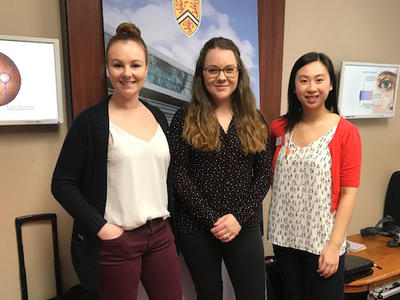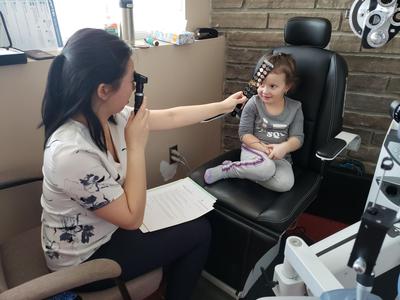Megan Ferguson Van Alstine jumped at the chance to join a team of Waterloo Optometry volunteers who are providing initial optometry clinic services to the Wiikwemikoong First Nation this year.
Growing up in Espanola Ontario, the young woman of Métis heritage fondly remembered having many high school classmates from the surrounding First Nations. Now she’s looking forward to returning to the area.
The third largest First Nation in Ontario, with a population of more than 3,100 people, Wiikwemikoong is located on the eastern shores of Manitoulin Island. While the community has its own onsite health centre, traveling to access specialized health care is part of daily life for its citizens. The nearest optometrist is located more than an hour’s drive away.
“Health care in rural Northern Ontario is often challenging to access due to a limited number of providers and a low population density,” Megan says. And with few public transportation options available in the north, access is even more difficult.
“This trip allows us to deliver vision care to people from my region who might not otherwise have access to these services in their home community,” she adds.

From left: WOVS student volunteers Megan Ferguson Van Alstine, Rachel Exler and Rachel Ng at the Wiikwemikoong Clinic.
Bridging gaps in health care
Dr. Andre Stanberry, Director of Waterloo’s Optometry Clinics at the School of Optometry & Vision Science (WOVS), is leading the clinics. Under his leadership, the School has launched several projects aimed at increasing access to preventative eye care in underserviced areas.
WOVS has offered pediatric clinics in inner city centres, and is now seeking to revive Waterloo’s involvement with the Indigenous population in northern Ontario.
Communities experience gaps in healthcare for several reasons, including distance and socioeconomic factors. We want to assist communities to bridge those gaps in the health care system and access the care they need. - Dr. Andre Stanberry
With funding assistance from Health Canada’s Non-Insured Health Benefits Program, Dr. Stanberry plans to offer three clinics in Wiikwemikoong over the course of the next year.
In addition to the three-week clinic now underway, the team will be back for another three-week stint in June, as well as in the fall of 2019.
Dr. Chandra Engs from WOVS, along with Espanola-based optometrist Dr. Josée Labrecque, have also volunteered their time with the team, along with Megan and fellow WOVS students Rachel Ng and Rachel Exler.
During each clinic, school-aged children and youth will receive comprehensive eye exams. Students who need eyeglasses will be fitted with two free pairs.
Innova Medical loaned the optical equipment to outfit the exam room. Lenses and frames are being provided free of charge for the first year of the clinic through the generosity of industry partners Hoya, Centennial Optical, OGI Eyewear, Bo Optik, Lanctot, Modo, and Marchon.
WOVS developed the project in collaboration with Dr. Paul Chris, Executive Director of the non-profit Vision Institute of Canada, and Mr. Tony Jocko, federal health policy analyst with the Anishinabek Nation (formerly the Union of Ontario Indians).
The Anishinabek Nation has forty member First Nations with a territory that stretches from Lake Nipigon in the north, to Sarnia in the south, and to the Ottawa Valley/Kawartha areas in the east. The Anishinabek Nation represents 60,000 Indigenous citizens of Ontario.
Having worked with Dr. Chris and the Vision Institute on two projects previously, Mr. Jocko has seen the great benefit of the projects first hand.
“If a child can’t see, they can’t read, and this can lead to less than optimal academic performance. The children and youth will benefit from comprehensive eye exams that weren’t previously available. Since citizens will be offered these services onsite, without the need to travel considerable distances to access vision care services, we hope to see a major uptake,” he says.
Once designed, the project was submitted to Wiikwemikoong Health Director Mary Jo Wabano, Health Services Director of Naandwechige-Gamig Wikwemikong Health Centre. She in turn brought it to her community advisory committee. Once the proposal received their stamp of approval, it was presented to Ogimaa Duke Peltier and his council for their endorsement. And when Dr. Stanberry and Dr. Chris, accompanied by Mr. Jocko, presented the idea to the Wiikwemikoong Chief and Council, they received a unanimous endorsement of the project.
Looking at health care through an Indigenous lens
The vision project isn’t just about what WOVS can bring to the community. It’s also about being open to learning from the people of Wiikwemikoong.
In preparation for the trip, the students learned about many of the health care challenges facing Indigenous people.
“Prior to attending Waterloo, I was aware of some of the health care risks that Indigenous people faced. The courses that we have been taking have provided us with the statistical rates for many health issues for both the on and off reserve population. It has opened our eyes to the fact that many systemic problems contribute to the state of health for our Indigenous citizens,” Megan observes.
For Rachel Ng, “what resonated with me the most was learning that the pain from colonization is present in all systems today. Mainstream education, law, and health care are generally Eurocentric. When an Indigenous person accesses health care today, it is important that the health care professionals are culturally sensitive, because the system itself is probably not. “
Both students are eager to explore health care from an Indigenous perspective.
“I hope to listen and learn the stories of Indigenous people from Indigenous people.” Rachel says. “I would also like to learn what specific ocular health needs people have, so that I can adapt my skills to learn how to address their needs both in a physically and culturally sensitive manner.”
Megan hopes to learn more about the traditional approach to wellness. “I feel that developing insight into the holistic approach will benefit my ability to provide comprehensive vision care to Indigenous patients.”
Beyond serving the immediate needs of Wiikwemikoong’s citizens, Dr. Stanberry hopes that the eye conditions that the optometrists encounter during the clinic visits will shed light on the vision care needs of First Nations communities, a topic we still know very little about. Every piece of knowledge gathered helps strengthen the case for establishment of a permanent clinic in Wiikwemikoong.

Student volunteer Rachel Ng examines a young patient at the WOVS eye care clinic at Wiikwemikoong First Nation.
Sustainable care and future careers
Rather than a band-aid solution, Dr. Stanberry’s goal is to create a sustainable model of vision care on Manitoulin Island. He and Dr. Chris hope to establish a full time clinic staffed by an optometrist and rotations of WOVS students.
Dr. Stanberry also hopes that Waterloo’s presence will have other positive effects that will contribute to the clinic’s success long term.
Dr. Chris adds that, “the clinic will not only teach the children and parents about the value and importance of eye exams, it will also introduce them to the profession of optometry as a possible career.”
Megan agrees. “Growing up in the region, my exposure to health care careers was limited, and it wasn’t until I attended university that I discovered optometry as a possible career. This trip for me is an opportunity to expose young people to careers in health care that they may be less familiar with. “
As Dr. Stanberry says, “We want these kids to see and have conversations with our students. We want to encourage more Indigenous people to become optometrists so that they—the people that are part of the fabric of these communities—return to provide the care. That’s our ultimate goal.”
Banner photo courtesy of Wiikwemikoong Tourism






